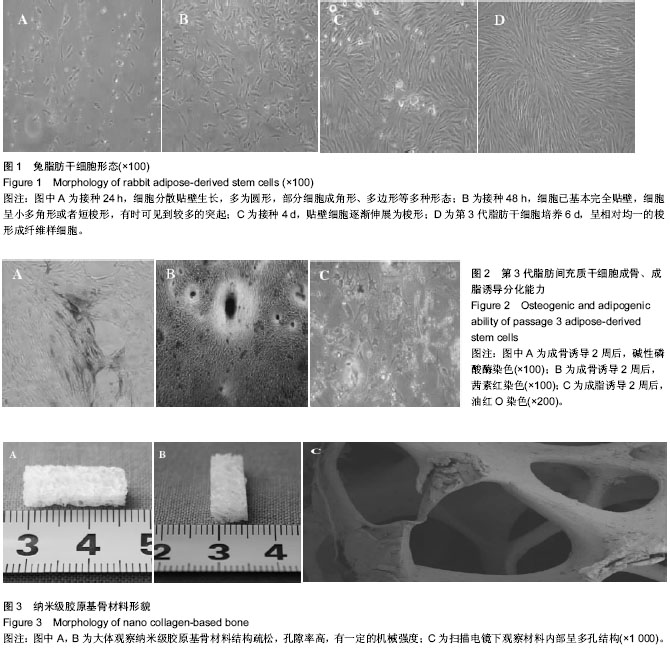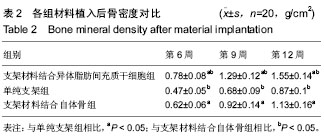| [1] 姬文晨,杨佩,张越林,等.脂肪干细胞及血管束植入法联合应用对组织工程支架体内血管化的影响[J].中国修复重建外科杂志, 2012,26(2):129-134.
[2] 曾宪利,杨春露.修复临界节段性骨缺损:组织工程骨支架形态及对种子细胞负载有效性的影响[J].中国组织工程研究,2014, 18(29):4717-4723.
[3] 顾涵身,金东生,历申儿.磁共振成像对股骨头坏死后塌陷的预测[J].现代医学,2011,39(2):194-196.
[4] Bai Y, Yin G, Huang Z, et al. Localized delivery of growth factors for angiogenesis and bone formation in tissue engineering. Int Immunopharmacol.2013;16(2):214-223
[5] 郭宜姣,李文华.骨缺损修复生物工程研究进展[J].中国骨质疏松杂志,2014,20(8):988-993.
[6] 王涛.普伐他汀干预兔激素性股骨头坏死的组织学观察[J].现代医学,2011,39(5):564-565.
[7] 谭志军,陈艳,张翠萍,等.微小RNA调控骨髓间充质干细胞分化的研究进展[J].中华实验外科杂志,2014,31(6):1389-1390.
[8] 张志宏,刘志礼,高志增,等.骨修复替代材料修复骨缺损的选择与应用[J].中国组织工程研究,2012,16(52):9836-9843.
[9] 李东亚,郑欣,邱旭升,等.新西兰兔桡骨骨缺损动物模型的制作[J].中华实验外科杂志,2013,30(9):2012-2013.
[10] 张屹,陈建常,史振满.异种骨支架及其衍生材料治疗骨缺损的研究现状与进展[J].中国矫形外科杂志,2014,22(14):1277-1279.
[11] Riggenbach MD, Jones GL, Bishop JY. Open reduction and internal fixation of clavicular nonunions with allograft bone substitute. Int J Shoulder Surg. 2011;5(3):61-67.
[12] 黄旋平,谢庆条,江献芳,等.慢病毒载体介导的基因治疗在骨缺损修复中的研究进展[J].中国矫形外科杂志,2014,22(14): 1284- 1287.
[13] 师彬,杨武斌,王平.骨髓间充质干细胞诱导分化成骨细胞的研究现状[J].中国实验方剂学杂志,2014,20(19):228-231.
[14] 陈佳滨,李强,茹嘉,等.腺病毒介导BMP-2和EGFP基因转染兔骨髓基质干细胞及种植脱钙骨的体外观察[J].中国骨质疏松杂志, 2014,20(8):869-874.
[15] Kajdaniuk D, Marek B, Foltyn W, et al. Vascular endothelial growth factor (VEGF) - part 2: in endocrinology and oncology. Endokrynol Pol. 2011;62(5):456-464.
[16] Lyons FG, Gleeson JP, Partap S, et al. Novel microhydroxyapatite particles in a collagen scaffold: a bioactive bone void filler. Clin Orthop Relat Res. 2014;472(4): 1318-1328.
[17] Tyndall A. Application of autologous stem cell transplantation in various adult and pediatric rheumatic diseases. Pediatr Res. 2012;71(4 Pt 2):433-438.
[18] 徐斌,周亮,王英明,等.同种异体脱钙骨与骨髓间充质干细胞关节腔内共培养:与同腔软骨性状的对比[J].中国组织工程研究,2014, 18(8):1165-1171.
[19] 代志鹏,许伟华,杨述华,等.人骨髓间充质干细胞的生物学特性及成骨诱导分化的研究[J].中国矫形外科杂志,2014,22(15):1402- 1407.
[20] 杨武斌,王平,师彬.骨髓间充质干细胞的成骨性诱导[J].中华中医药学刊,2014,32(9):2158-2160.
[21] Getgood AM, Kew SJ, Brooks R, et al. Evaluation of early-stage osteochondral defect repair using a biphasic scaffold based on a collagen-glycosaminoglycan biopolymer in a caprine model. Knee. 2012;19(4):422-430.
[22] McBane JE, Sharifpoor S, Cai K, et al. Biodegradation and in vivo biocompatibility of a degradable, polar/hydrophobic/ionic polyurethane for tissue engineering applications. Biomaterials. 2011;32(26):6034-6044.
[23] 耿海霞,封伟,钱君荣,等.羟基磷灰石-凝胶支架复合成骨细胞修复兔颅骨缺损的组织学评价[J].临床口腔医学杂志,2014,30(9): 519-521.
[24] Brenneman M, Sharma S, Harting M, et al. Autologous bone marrow mononuclear cells enhance recovery after acute ischemic stroke in young and middle-aged rats. J Cereb Blood Flow Metab. 2010n;30(1):140-149.
[25] 武海军,银和平,李树文,等.密度梯度离心和贴壁筛选法分离培养兔骨髓间充质干细胞的形态学观察[J].中华临床医师杂志:电子版, 2012,6(22):7261-7265.
[26] Rosset P, Deschaseaux F, Layrolle P. Cell therapy for bone repair. Orthop Traumatol Surg Res. 2014;100(1 Suppl): S107-112.
[27] Tobita M, Mizuno H. Adipose-derived stem cells and periodontal tissue engineering. Int J Oral Maxillofac Implants. 2013;28(6):e487-493.
[28] Sen RK, Tripathy SK, Aggarwal S, et al. Early results of core decompression and autologous bone marrow mononuclear cells instillation in femoral head osteonecrosis: a randomized control study. J Arthroplasty. 2012;27(5):679-686.
[29] 胡金龙.组织工程学技术治疗骨缺损的最新研究进展[J].中国矫形外科杂志,2013,21(2):150-153.
[30] Wang BL, Sun W, Shi ZC, et al. Treatment of nontraumatic osteonecrosis of the femoral head with the implantation of core decompression and concentrated autologous bone marrow containing mononuclear cells. Arch Orthop Trauma Surg. 2010;130(7):859-865. |


